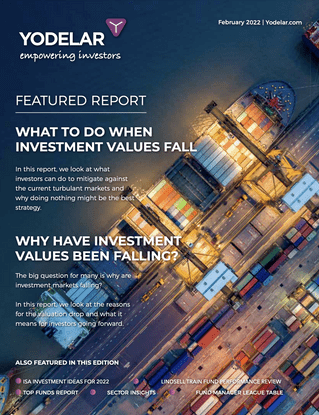The Financial Services Compensation Scheme (FSCS) is the UK’s statutory compensation scheme for customers of financial products that have failed. It is an important safeguard for investors but due to its threshold, tens of thousands of investors and billions of their assets are overexposed and not protected.
Since 2001, the FSCS has helped more than 4.5 million people and paid out more than £26 billion. But the issue is, the scheme can only compensate up to a maximum of £85,000 per provider. So, if you are invested with one provider or in products such as multi asset funds or ready made portfolios, any investment above the FSCS threshold will be exposed and not protected.
Key Findings
The FSCS is the UK’s statutory compensation scheme that pays investors compensation up to a maximum of £85,000 per provider. Its purpose is to protect investors should an investment firm who is responsible for a fund fail or be unable to pay claims against it.
Many large brands have indirectly exposed clients to a lack of protection. As an example, the UK’s largest restricted wealth management firm St. James’s Place only invests client money in their own brand of funds, which means all SJP investors are only protected up to a maximum of £85,000 even if their portfolio is significantly larger.
SJP has over 700,000 clients with an average portfolio size of £156,000, resulting in an average SJP client having government protection of only 54%.
The vast majority of medium to large Hargreaves Lansdown portfolios our research team review (via our free portfolio analysis service - click here for more information) find that a large proportion is invested in HL’s own funds. Such investors limit their protection under FSCS rules.
In recent years there has been a surge in the popularity of multi asset funds and ready made portfolios, yet many of these products are made up of a selection of funds owned by one provider. As a consequence, many investors are unaware that anything over £85,000 is not protected by the FSCS.
Over 13 million workplace pension members and 728,000 employers are invested in pension schemes that are managed by just 5 different providers, which has left millions above the FSCS threshold for compensation. The 5 biggest providers include well known brands such as Legal and General and Standard Life.
To maximise protection under the FSCS and mitigate the risk of loss investors must spread their portfolio across a number of providers, and have no more than £85,000 with one provider, such as Fidelity, Aviva, Invesco, St James’s Place or Hargreaves Lansdown.
The Implosion of Neil Woodford’s Investment Empire
The implosion of Neil Woodford’s investment empire has plunged rival fund managers into crisis mode as they try to salvage the reputation of an industry that finds itself under the scrutiny of regulators and politicians.
“We have seen the complete demise of the most famous fund manager the UK has seen for years,” said Adrian Lowcock, head of personal investing at stockbroker Willis Owen. “Investors knew the scenario was bad but the indication from Woodford had been that the fund would reopen. Sadly, many people are faced with significant losses.”
Up to 300,000 investors - many of whom used their life savings - are facing huge losses after administrator Link Asset Services said the value of the fund had fallen by almost 19%.
The collapse of Woodford Investment Management came about after their flagship equity income fund, which at its peak stood at £10.2 billion, sustained prolonged periods of underperformance. Woodford's troubles came to a head in June 2019, when he ran out of cash reserves to return to investors who were fleeing his Equity Income fund in their droves (at the time of suspension the fund had fallen in size to below £4 billion).
The fall of the UK's most famous fund manager in such a short period of time demonstrates the vulnerability of fund management and emphasises the importance for investors to spread their investments across a range of fund providers to get the full benefit of the FSCS protection.
How Investing In Readymade Portfolios & Multi Asset Funds Limits Investor Protection
Readymade portfolios and multi asset funds are a novel way for fund management brands to sell more of their own funds. They are doing this by using their own range of funds to form the underlying holdings of these products.
For example, Hargreaves Lansdown’s Portfolio+ range is a selection of readymade portfolios that are balanced to fit a set risk profile. The underlying holdings of these portfolios are exposed to several different asset classes and Hargreaves Lansdown spread the weighting of their portfolio across these asset classes to meet the appropriate risk level. The underlying holdings used for these portfolios are also funds owned by Hargreaves Lansdown.

Multi asset funds are similar to readymade portfolios in that their underlying holdings are balanced across different asset classes to fit a target risk model. One of the most popular multi asset funds on the market is the Vanguard LifeStrategy 60% Equity fund, which is responsible for more than £8 billion of client money. This fund is made up entirely of a selection of underlying funds that are owned by Vanguard.
The benefits of these products for providers is that they get paid when investors invest, they also get paid as the underlying funds used to form the multi asset fund or readymade portfolio typically incur transaction charges and management fees that the investor must pay.
Such products offer an element of convenience, but their overall value is minimal. When it comes to performance, no fund management firm has a monopoly on the best funds, hence, the multi asset funds and readymade portfolios that contain the funds of just one provider will ultimately hold a proportion of underlying funds that underperform.
Investing requires a degree of flexibility which multi asset funds and readymade portfolios simply lack. As well as falling short on quality, many investors in multi asset funds and readymade portfolios miss out on the full benefits offered by the FSCS, simply because these products are typically owned by one fund management brand, which instantly caps the compensation limit of the FSCS at £85,000 per investor.
Why Many Workplace Pensions Could Have Put Their Members At Greater Risk
Some company pensions allow their employees to invest in a wide range of funds, while others offer a very limited selection or no choice at all.
According to The Pensions Regulator (TPR), the number of people whose pension is saved in a master trust has risen from 270,000 in 2012 to more than 13 million – nearly two in five workers in the UK (37%).
Although it is a positive that more people are invested in pension products the concern is that just five schemes manage more than £17 billion and account for the majority of the 13 million members and 728k employers. The five providers are: Legal and General WorkSave Master Trust and RAS Master Trust, NEST Pensions, NOW: Pensions, Standard Life DC Master Trust and Stan Plan, and The People’s Pension.

As the FSCS limit compensation for each claim to a maximum of £85,000 per provider, the fact that just 5 providers account for the majority of workplace pensions, shows that many members have significant restrictions in the amount their pensions are protected. With this coming to light, some employers are now concerned that should the provider they chose fail, they could potentially be put under the spotlight for failing to ensure their employees had the benefit of greater protection.
Employers could be responsible or even liable in offering such schemes if aware they are limiting scheme member protection.
Could SJP’s Strategy of Loaning Their Advisers Money Put Their Clients At Risk?
St James’s Place has more than doubled in size in the past 5 years in no small part because of an ambitious growth strategy fuelled by millions of pounds they loaned to their partnership businesses.
In 2013, SJP Partnership Services, the company that provides loans to businesses within the SJP Partnership, published its first financial statements on Companies House. These revealed it had written £9 million of loans, with a further £17.6 million bridged by the company on a short-term basis while external funding was found.
By 2018, SJP Partnership Services had written long-term loans, due to be paid back within five-to-10 years, of £254.2 million. Short-term loans, due within less than a year, stood at £33.6 million.
Is basing growth on such a heavy borrowing programme such a good thing in the long term for SJP or its advisers?
Goldman Sachs managing director Johnny Vo pointed out that SJP’s borrowing rose from £168.5 million on 30 June 2018 to £451.2 million at the same point just a year later.
In addressing SJP’s borrowing Mr Vo said “Your borrowings have gone up quite dramatically, and your debt-to-equity ratio is quite high by historical standards. It’s also consistent with your cashflow statement which, if you remove your financing, is negative or zero.”
Another concern with this strategy is that it is based on the assumption that advice fee income will keep on rising. But there are reasons to suspect the amount of new money coming into SJP might slow. The regulator has signalled plans to ban contingent charging on defined benefit pension transfers and, possibly more significantly, force advisers to do more to justify ongoing fees. SJP are one of the most expensive firms on the market, making their advice income look less secure.
Their unique charging structure is ingrained in their business model and is critical to how they pay their partner advisers, making it almost impossible for them to change. One of the main issues within their model is that they are inherently expensive and require commitment from investors for up to six years or they face financial penalties for leaving. Investors are becoming increasingly less tolerant to this model, and their tolerance will only get worse.
Should investors choose other advice models and the number of new monies into SJP falls it could impact on the ability of partner advisers to repay their loans.
The growth of SJP has certainly come at a cost, and should they struggle to attract sufficient inflows of new money, it could have huge implications for the firm.
For investors, there is growing concern that should restricted advice models such as St. James’s Place fail, they might not benefit from the full protection afforded by the FSCS. As a restricted wealth manager, SJP only invests their clients’ money in SJP funds, which means any investment above the FSCS £85k threshold is not covered by the FSCS. This would have a big impact on SJP’s clients who on average have £156,000 invested with the firm.
How Independent Financial Advice Can Add Protection
It is important to note that financial advisers do not hold any of their clients’ money. All money invested in a portfolio of funds is held by the management firm of each fund’s management brand. Therefore, should an advisory firm fail investors are unaffected.
Having an adviser who plans against overexposure to one provider and puts in place a diverse portfolio of multiple providers can be of great value to investors.
Diversify For Greater Safety
The risk for investors is ‘should a fund management brand who owns/manages the funds you are invested in fail to cover their commitments then your money could be at risk’.
As identified earlier, restricted firms such as St. James’s Place, as well as multi asset funds and readymade portfolios, provide products that are owned and operated by one fund management brand. This means that any investment in such products above £85,000 will not be protected by the FSCS.
The chances of a fund management firm failing is small but as highlighted by the fall of the UKs most recognisable fund manager Neil Woodford, protecting against such scenarios should not be overlooked.
To maximise protection under the FSCS and mitigate the risk of a fund provider failing investors must spread their portfolio of funds across several different providers. Yodelar Investments employs a comprehensive process for building and maintaining efficient portfolios for performance and security.
The selection process for the funds and fund managers we use within our investment portfolios requires them to meet key performance metrics, but their inclusion is also based on other criteria such as how well-established the management firm is, the field of expertise of the fund manager, the consistency of their funds and their fund charges.
We use such information to help ensure the funds that we invest our client’s money in are highly efficient and consistently good performing. For enhanced security through the FSCS we also ensure that our portfolios are balanced across several different fund management brands.













